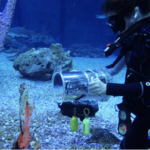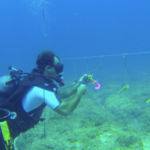Underwater 3D Capture using a Low-Cost Commercial Depth Camera
This paper presents underwater 3D capture using a com- mercial depth camera. Previous underwater capture sys- tems use ordinary cameras, and it is well-known that a cali- bration procedure is needed to handle refraction. The same is true for a depth camera being used underwater. We de- scribe a calibration method that corrects the depth maps of refraction effects. Another challenge is that depth cameras use infrared light (IR) which is heavily attenuated in water. We demonstrate scanning is possible with commercial depth cameras for ranges up to 20 cm in water. The motivation for using a depth camera under water is the same as in air – it provides dense depth data and higher quality 3D reconstruction than multi-view stereo. Under- water 3D capture is being increasingly used in marine biol- ogy and oceanology; our approach offers exciting prospects for such applications. To the best of our knowledge, ours is the first approach that successfully demonstrates underwater 3D capture us- ing low cost depth cameras like Intel RealSense. We de- scribe a complete system, including protective housing for the depth camera which is suitable for handheld use by a diver. Our main contribution is an easy-to-use calibration method, which we evaluate on exemplar data as well as 3D reconstructions in a lab aquarium. We also present initial results of ocean deployment.
Learn about our two Decals!
 Click here to find out more about our Fall Bioinspired Design Decal and our Spring Bioinspired Design in Action Decal – ALL MAJORS are welcome.
Click here to find out more about our Fall Bioinspired Design Decal and our Spring Bioinspired Design in Action Decal – ALL MAJORS are welcome.Berkeley BioDesign Community
 Click here to learn about the BioD: Bio-Inspired Design @ Berkeley student organization or here to signup for more info.
Click here to learn about the BioD: Bio-Inspired Design @ Berkeley student organization or here to signup for more info.Search
Student Login






I imagine that the neurological circuits underlying these processes are governed by both 2d spacing maps with their brains as…
to reduce the impact of car accidents, it may be possible to study the force diverting physics of cockroaches to…
you see this type of head-bobbing stability in many avian creatures related to pigeons like chickens. the head ability to…
not like they taught horses how to run! this is an example of convergent evolution where both sea creatures and…
The brain functions in a similar way with neuronal connections. our brains are able to utilize the multiplicity of connections…